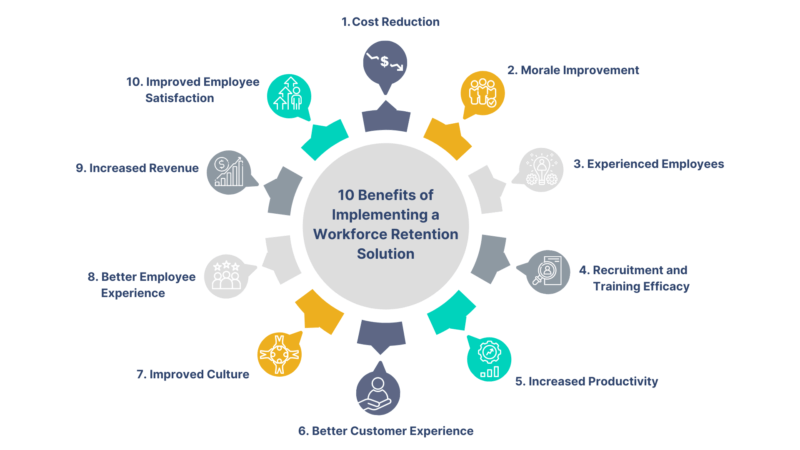The supply chain continues to struggle with labor shortages, and employee turnover has significantly contributed to this problem. Workforce retention impacts all aspects of a business, from operational costs, to productivity, to company culture. In order for companies to overcome the labor crisis, they must prioritize retaining employees in 2023.
WorkStep’s employee retention software can help you achieve your goals with advanced features and insights designed to support your retention strategy.
Let’s look at 10 benefits to implementing a workforce retention strategy:
1. Reduce costs
Turnover costs for a company are expensive – maybe costing even more than calculated. Aside from the hefty investments in recruiting, interviewing, onboarding, and training (remember, this includes the salary of the new hire as well as the staff conducting these tasks), turnover can impact productivity, morale, company culture, and the company’s reputation as an employer.
2. Boost company morale, become an employer of choice
It’s hard to continue feeling positive about a job or an organizations if you’re constantly hearing co-workers complain or express a desire to quit, maybe even about their job searches. This drags down the morale of the team and can lead to a widespread reassessment of satisfaction, and ultimately more resignations. Bonus: boosted company morale can result in ranking as a best place of work and becoming an employer of choice!
3. Retain your experienced employees
Although a company may hire someone with similar experience to fill the role of a tenured employee, it’s impossible to replace their business knowledge and the relationships that were built. The impact of a senior-level employee leaving trickles through the entire organization, affecting productivity, morale, and even succession planning.
4. Efficiently recruit and train employees
If new hires are leaving at a rapid pace, then the money invested in recruiting, training, and onboarding leaves with them. Until retention becomes a priority, this cycle will continue to happen, causing companies to unnecessarily hemorrhage money.
5. Increase workplace productivity
Every time an employee leaves and a new person is hired for that role, you’re rolling back the clocks on productivity. It takes time for a new hire to get up to speed and be able to perform tasks as quickly and skillfully as the person they replaced.
As more employees quit, the motivation of existing workers wanes and productivity inevitably plummets.
6. Better customer experience
If a customer has a negative experience with a company, it only takes a few minutes and clicks to share that experience with the world. If a person at a company is unhappy in their role or with the organization, it’s likely those sentiments will be projected in their interaction with customers.
7. Improve company culture
When an organization makes efforts to retain their frontline workers by listening to what’s impacting their satisfaction, it sends a message that they value their employees and sets a tone for the overall company culture. This cultivated culture becomes part of the company’s brand and can significantly impact recruitment efforts. If a business is positioned as an employer with a positive culture they are likely to attract stronger candidates who will retain.
8. Better employee experience
There is a lot more to a positive employee experience than what human resources has control over. Strong relationships with co-workers and management can help someone feel supported and valued. Transparency from the executive level can build employee trust. Both can influence company pride, which breeds company loyalty, helping curb turnover.
9. Increase revenue
The bottom line is, well, the bottom line. Every aspect of employee retention affects business revenue. From the costs of hiring and training, to productivity, to company culture, reducing attrition impacts the financial well being of a business.
10. Improve employee satisfaction
Engaging employees is key for improving satisfaction. If an employee feels they have a voice and are heard by the company they work for, they in turn feel valued. Empowering workers to give feedback and using that feedback to make individual or institutional changes will improve employee satisfaction.
Providing a platform that enables staff to anonymously voice their opinion or grievances regularly throughout their employment journey helps companies learn the true needs of their employees. This allows management to make real-time changes that will increase employee retention and ultimately make the company a better place to work.
Retain your employees for the long-haul
Reduce turnover, increase productivity, and build a loyal and engaged workforce with WorkStep.
Kristina Finn, Content Marketing Manager | kristina@workstep.com




